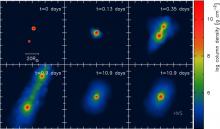
Abstract
In Paper I, we followed the evolution of binary stars as they orbited near the supermassive black hole (SMBH) at the Galactic center, noting the cases in which the two stars would come close enough together to collide. In this paper we replace the point-mass stars by fluid realizations, and use a smoothed-particle hydrodynamics (SPH) code to follow the close interactions. We model the binary components as main-sequence stars with initial masses of 1, 3 and 6 Solar masses, and with chemical composition profiles taken from stellar evolution codes. Outcomes of the close interactions include mergers, collisions that leave both stars intact, and ejection of one star at high velocity accompanied by capture of the other star into a tight orbit around the SMBH. For the first time, we follow the evolution of the collision products for more than 100 orbits around the SMBH. Stars that are initially too small to be tidally disrupted by the SMBH can be puffed up by close encounters or collisions, with the result that tidal stripping occurs in subsequent periapse passages. In these cases, mass loss occurs episodically, sometimes for hundreds of orbits before the star is completely disrupted. Repeated tidal flares, of either increasing or decreasing intensity, are a predicted consequence. In collisions involving a low-mass and a high-mass star, the merger product acquires a high core hydrogen abundance from the smaller star, effectively resetting the nuclear evolution "clock'' to a younger age. Elements like Li, Be and B that can exist only in the outermost envelope of a star are severely depleted due to envelope ejection during collisions and due to tidal forces from the SMBH. We discuss the implications of these results for the formation of the S-stars and the hypervelocity stars.